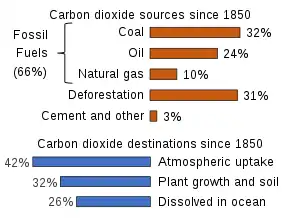Carbon source
In biology, carbon source refers to the molecules used by an organism as the source of carbon for building its biomass.[1] A carbon source can be an organic compound or an inorganic compound. Heterotrophs needs organic compounds as source of carbon and source of energy, while autotrophs can use inorganic compounds as carbon source and an abiotic sources of energy, as light (photoautotrophs) or inorganic chemical energy (chemolithotrophs).[2] The biological use of carbon is part carbon cycle, where it starts from an inorganic source of carbon, such as carbon dioxide, that passes through the process of carbon fixation.

Between 1850 and 2019 the Global Carbon Project estimates that about 2/3rds of carbon dioxide emissions have been caused by burning fossil fuels, and a little less than half of that has stayed in the atmosphere.
References
- reece, Jane B. Reece, Berkeley, California, Lisa A. Urry, Mills College, Oakland, California, Michael L. Cain, Bowdoin College, Brunswick, Maine, Steven A. Wasserman, University of California, San Diego, Peter V. Minorsky, Mercy College, Dobbs Ferry, New York, Robert B. Jackson, Stanford University, Stanford (2014). Campbell biology (Tenth ed.). ISBN 9780321775658.
- Tortora, Gerar (2018-01-08). Microbiology: An Introduction. Pearson. ISBN 9780134605180.
This article is issued from Wikipedia. The text is licensed under Creative Commons - Attribution - Sharealike. Additional terms may apply for the media files.